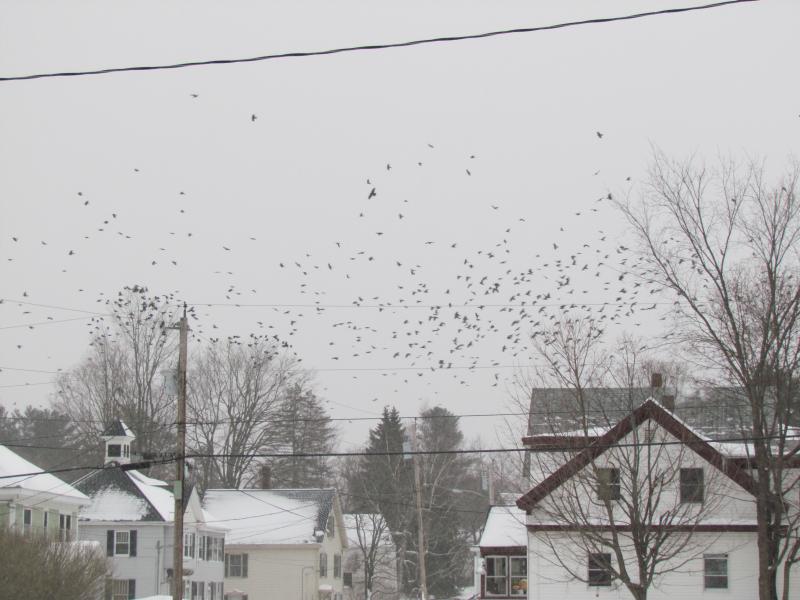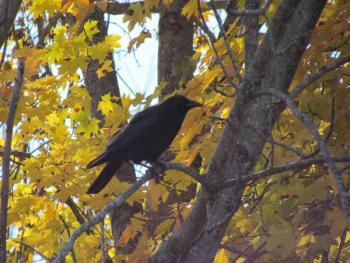As the Maine landscape turns from shades of green to brilliant oranges and reds and porches are adorned with pumpkins, skeletal; creatures, and witches in black hats, it’s the time for the fall gatherings of crows.
In our neighborhood over the past week, as dusk quietly settles, suddenly there have arrived bunches of crows. At first, they call raucously, amassing and swirling in the tree tops. As it gets darker, the numbers can grow into the hundreds, but they become quiet. They are trying to find a safe place to roost for the night, presumably a place where they won’t be attacked by what must be their most terrifying predator—a great horned owl.
Last night, well after dark, we heard a single “caw” of an alarmed crow erupt from the inky blackness and then, dimly lit by the streetlights, hundreds of crows poured overhead in silence, the fluttering of their wings the only sound.
The fall-winter roosts of crows are a spectacle of bird abundance that, in today’s world, are one of the few experienced by large numbers of people. Some of these crow roosts number into the tens of thousands, a few even into the hundreds of thousands or occasionally over a million. The ones we have seen in Maine are more likely into the thousands.
There is something enthralling about the sight large numbers of birds or other animals. Here in Maine, the occasional occurrence of thousands of ducks and geese or shorebirds at a migratory hotspot is something that is not forgotten. Even when we see thousands of gulls, joined by dozens of eagles and crows, at a smelly dump, we are thrilled!
These spectacles of bird abundance pale in comparison to those from the past that none of us will ever see. The most famous is, of course, the unfathomable flocks of passenger pigeons. Very credible ornithologists described flocks that darkened the skies for hours or even days as they passed over in migration. These had to have numbered well into the millions. The total population size is estimated to have been in the billions.
Yes, we had passenger pigeons right here in Maine. The last known one in the state was one collected on Mount Desert Island in 1904. Here in Maine, there are Pigeon Hill Roads in Columbia, Mechanic Falls, and Steuben, a Pigeon Plain Road in China, a Pigeon Brook Road in West Baldwin, a Pigeon Point in Lovell, a Pigeon Island in Deer Isle, and a Pigeon Road in Ellsworth. While we don’t know the origins of these place names, we wonder if at least some of these were named after places where nesting colonies of passenger pigeons were located or where they occurred in migration and were hunted in great numbers as they were across their range until their extinction in 1914. There is something incredibly poignant about the idea we can visit these places that carry a name of a bird species that was so alive and memorable that it was named for it. It’s like there are memories—ghosts—of passenger pigeons trying to remind us of the need to take care of the birds, wildlife, plants, and the entire environment around us.
Jeffrey V. Wells, Ph.D., is a Fellow of the Cornell Lab of Ornithology and Vice President of Boreal Conservation for National Audubon. Dr. Wells is one of the nation's leading bird experts and conservation biologists and author of the “Birder’s Conservation Handbook.” His grandfather, the late John Chase, was a columnist for the Boothbay Register for many years. Allison Childs Wells, formerly of the Cornell Lab of Ornithology, is a senior director at the Natural Resources Council of Maine, a nonprofit membership organization working statewide to protect the nature of Maine. Both are widely published natural history writers and are the authors of the popular books, “Maine’s Favorite Birds” (Tilbury House) and “Birds of Aruba, Bonaire, and Curaçao: A Site and Field Guide,” (Cornell University Press).

























